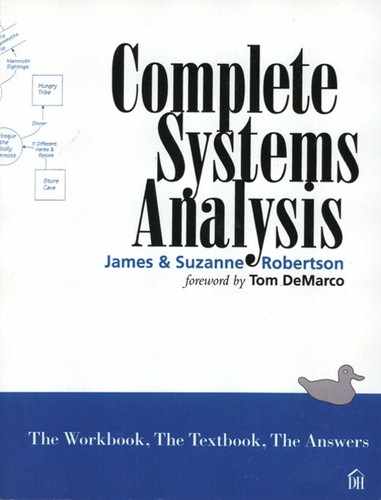1.13. More Events
Your Strategy
This chapter asks you to produce models for sixteen event-response models. We want to give you the best possible opportunity to practice and perfect your essential modeling skills. The strategy that you use depends on you.
What problems are you having with essential event-response models? If you are having trouble identifying all the processes that respond to an event, try thinking of yourself as a data tracker. For an external event, track the triggering data flow as it ripples into and out of processes that may be relevant. To decide whether a process is relevant, use the name of the event as a guide. Ask, “Does this process fragment respond to the event I am modeling? Or is it part of another event-response?” The track of an external event-response ends when all the resulting data flows have either been stored or been sent to the terminators. Tracking a temporal event-response is done in the same way except that it starts at the data and ends outside the system at a terminator.
If you are having trouble coping with a particularly complex event, stand back and apply a top-down approach. Try starting with an essential activity model. Draw a bubble and identify all the boundary data flows and stores for the event. This provides you with a context for the event-response. Refer to the latest version of the data model to help you identify the data entities and relationships that are relevant to this event. Use these entities and relationships to build an event-response data model for each event before you attempt to partition the event-response into smaller processes.
Sometimes, you will need to vary your strategy. If your knowledge of the event-response is fragmented, for example, you might start by developing an event-response process model that contains many processes. Then refine the model to remove any implementation-dependent data or process, leaving only the essential requirements.
Building the event-response data model first often provides you with insights that will help you with the event-response process model. To assist you in building this data model, we suggest that you use the boundary data flows (shown in the event list) for each event. Every data element in the boundary data flows is either an attribute of an entity or a relationship, or it is calculated by your event-response. This means that the data elements in the boundary flows help you to identify the entities and relationships that are relevant to the particular event-response.
If you have trouble deciding what is essential and what is implementation dependent, try thinking in a different way. Our Atlantic Systems Guild partners Steve McMenamin and John Palmer propose the notion of “perfect technology.” They explain this concept in their book, Essential Systems Analysis, as follows: Imagine, within your context of study, that you have access to devices that are infinitely fast, cost nothing, are totally reliable and infallible, and have infinite data storage. Now that you have this technology, for each process, flow, and store in the physical model, ask, “Do I need this process, flow, or store now that I have perfect technology? Does this do something essential, or does it support the old, less-than-perfect technology?”
As you build your models, update the data dictionary to include any new data flows, entities, and relationships. Finally, write a mini specification for each essential process.
 Ski Patrol
Ski Patrol
Attention, all readers: Study the following tips and guidelines before reading the “What to Do” section and before starting the exercise.
To begin, choose the easiest event-response to model first. Which one is the easiest? Whichever one appears the simplest to you. In your work with the Piccadilly Project, you probably consider some aspects to be simpler than others; that’s usually because you’ve had experience with similar subject matter in another project. If you still cannot decide how to start, use the complexity of the event’s input and/or output data flows as an indication of the event’s complexity.
If you are having trouble modeling one event-response, leave it and try another. Each event will teach you something new about event-response modeling. Give yourself a chance to learn from your own success.
If your chosen modeling approach is not working, change it and select a strategy that you have not tried. Be prepared to vary your approach. The commentaries in Chapter 3.12 will provide you with illustrations of a variety of strategies. These new insights will help you to retry the events that you have trouble with.
For help on how to build event-response models, refer to Chapter 2.11 Event-Response Models. If you had any trouble with modeling the data, review Chapter 2.5 Data Models. These chapters both provide explanations and exercises to improve your modeling skills. The rationale for building these models is in Chapters 2.10 Essential Viewpoint and 2.4 Data Viewpoint. Refer to these chapters if you have difficulty understanding any of the event-response explanations in Chapter 3.12.
